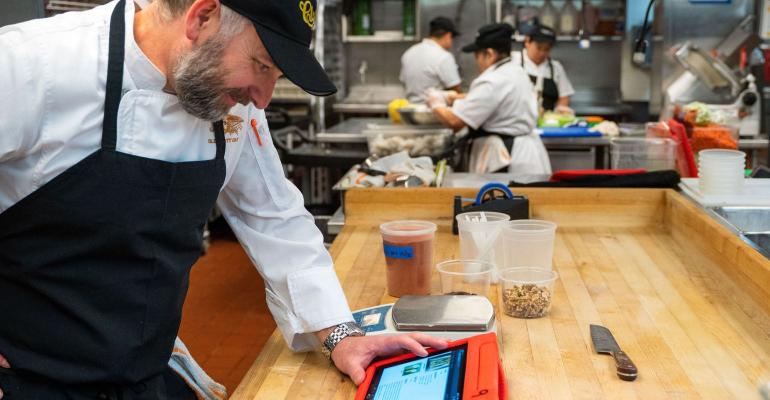Sponsored by MarginEdge
In the fast-paced, competitive world of hospitality, efficiency is paramount to scalable growth for multi-unit restaurant operations. Large national chains often have proprietary systems optimized for their specific needs and operation requirements, and independent operators can often manage margins with off-the-shelf solutions from the POS or 3rd party integrators. But what about the groups that fall in between?
Restaurant Management Systems (RMSs) are comprehensive software solutions designed to streamline operations, centralize management, and improve financial accuracy for restaurants by combining back office tasks, like ordering, inventory, recipe management, bills, budgeting and cost management all in one place. They are crucial to achieving further growth for small-to-midsize emerging restaurant brands. Here are the top 4 ways an RMS can transform how you run your multi-unit restaurant business.
1. Powerful Centralization - All Units at Your Fingertips
Imagine glancing at a single interface and having comprehensive oversight over multiple restaurant units. An end-to-end RMS aggregates sales data, inventories, orders, and more into one dashboard, providing a real-time holistic view of your business's financial and operational health.
Gone are the days of bouncing between tabs (or physical pieces of paper) to pull out each unit’s financial and operational performance; now, a few clicks reveal everything. The convenience and proactive insights gleaned from this centralized system empower operators to make strategic decisions and stay ahead of market shifts. Being able to see performance in one place makes it easier to spot opportunities for improvement, which will enable your teams to bolster growth with data-driven solutions.
2. Swift and Seamless Cross-Unit Changes
In the ever-changing world of product prices, the ability to quickly adapt is a necessity. An RMS allows for instant cross-unit changes for menu items, recipes, and prices. Want to remove a special that just jumped up to 45% food cost across multiple stores thanks to a sudden price fluctuation? Done.
Ready to push out new seasonal menu items to align with your customers' tastes and trending preferences? A couple of clicks and it’s live. This flexibility, managed from a single platform, enhances not only operational agility but also the cohesive customer experience across all establishments. You no longer need to worry if all your stores get the memo because communications are automatically streamlined.
3. Consistent Staff Training Through RMS Recipe Books
When it comes to positive guest experiences, properly training your staff across units for consistency is key. An RMS offers digital recipe books that can be used to standardize training and prep across units.
From the exact quantities to the step-by-step process in written, photo and even video formats, digital recipe books ensure every staff member is working with the same recipe. This not only guarantees that the taste and quality of your dishes are uniform but also accelerates onboarding and minimizes training errors with lower labor costs. You can finally ditch those bulky binders as recipe changes are automatically updated globally across all or just selected units which is a huge time savings.
4. Unified Commissary and Internal Transfer Management
Efficient inventory management for any restaurant is the key to honing in on food costs and maximizing margins. Just like with recipes, an RMS ensures that count sheets are always accurate across all locations, helping streamline inventory processes, which is critical to controlling costs and comparing apples to apples between stores (sometimes literally).
Tracking internal transfers, including commissary orders, is easy with an RMS thanks to a centralized location to record and manage products flowing between stores that are already connected in the software. You can change prices, utilize a digitized log to adjust inventory levels accordingly and ensure that each transfer is accounted for financially. This advanced tracking means less waste, fewer discrepancies, and lower food costs - benefits that directly boost your bottom line.
RMS commissary functions automate the management of complex, kitchen-to-kitchen transfers by treating the commissary as a standalone vendor. Staff can order ready-made items from the central kitchen, just as they would from a vendor, complete with an invoice detailing order tracking and associated costs.
Big Picture Insights Lead to Unmatched Growth
By leveraging an RMS, you gain the ability to forecast and distribute resources effectively based on the unique demands of each location. Additionally, by analyzing transfer data, restaurant managers can identify patterns and optimize both their ordering and transfer strategies, leading to even greater efficiency and savings.
In summary, using an RMS is not just about keeping up with the tech times; it's an intelligent, strategic move in the competitive multi-unit restaurant space. Integrating such a comprehensive system unlocks the potential for enhanced management, streamlined operations, and a significant leap in customer satisfaction. To learn more about what features to look for in an RMS, or if you’re interested in seeing how an end-to-end RMS solution can help bolster your business’ growth, check out MarginEdge.




